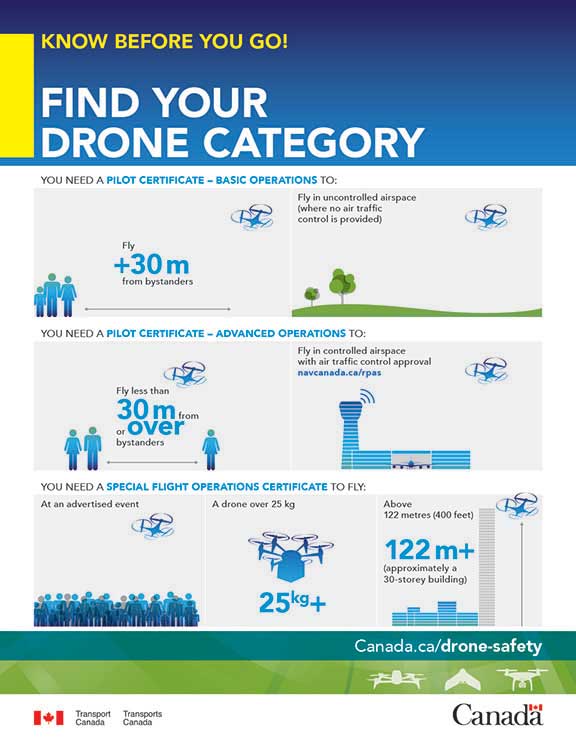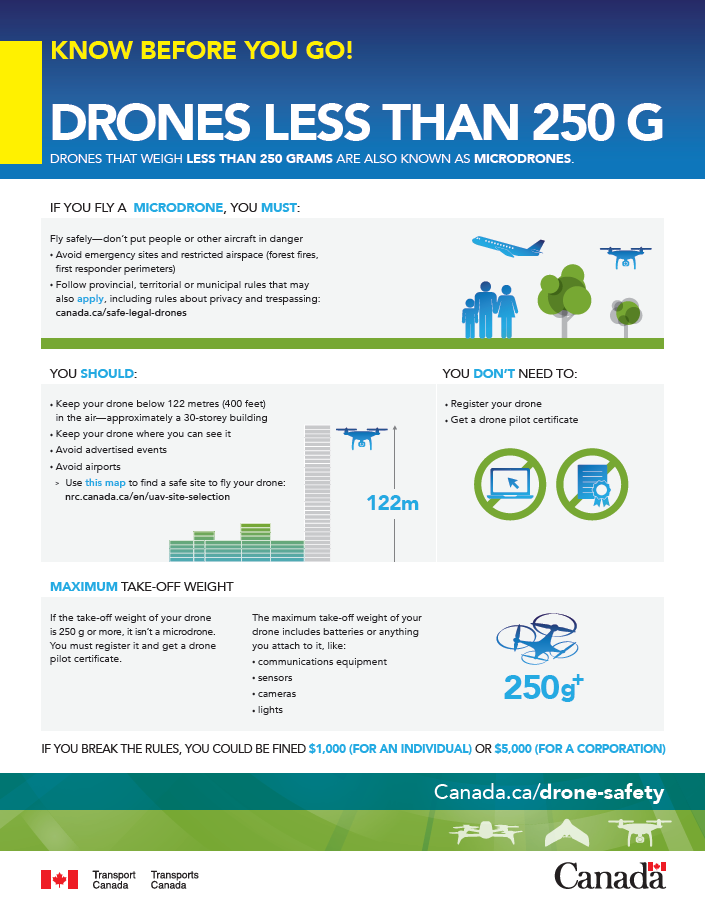In Canada, there are 2 main categories of drone operation: basic and advanced. Each one has a different set of rules drone pilots must follow.
The weight of your drone, distance from bystanders and airspace rules define your category. The rules do not treat people who fly drones for fun or for business differently.
On this page
Basic operations
If you meet all 5 of these conditions, you're conducting basic operations:
- You fly it in uncontrolled airspace
- You fly it more than 30 metres (100 feet) horizontally from bystanders
- You never fly it over bystanders
- You fly it more than 3 nautical miles from a certified airport or a military aerodrome
- You fly it more than 1 nautical mile from a certified heliport
If you do not meet any 1 of these 5 conditions, you are conducting advanced operations.
For example, let’s say you fly your drone more than 30 metres (100 feet) horizontally from bystanders but in controlled airspace. This operation is advanced because you’re flying in controlled airspace even if you’re more than 30 metres (100 feet) horizontally from bystanders.
For basic operations, here are some of the rules you must follow:
- Register your drone with Transport Canada before you fly it for the first time
- Mark your drone with its registration number
- Pass the Small Basic Exam
- Be able to show your Pilot Certificate – Basic Operations and proof of registration when you fly
Advanced operations
If you meet any 1 of these conditions, you are conducting advanced operations:
- You want to fly in controlled airspace
- You want to fly over bystanders
- You want to fly within 30 metres (100 feet) of bystanders (measured horizontally)
- You want to fly less than 3 nautical miles from a certified airport or a military aerodrome
- You want to fly less than 1 nautical mile from a certified heliport
For advanced operations, here are some of the rules you must follow:
- Register your drone with Transport Canada before you fly it for the first time
- Mark your drone with its registration number
- Have a drone with the appropriate Safety declaration for the intended operation
- Pass the Small Advanced Exam
- Pass a flight review with a flight reviewer
- Be able to show your Pilot Certificate – Advanced Operations and proof of registration when you fly your drone
- Seek permission from air traffic control (NAV CANADA or the Department of National Defence) to fly in controlled airspace (request an RPAS Flight Authorization from NAV CANADA)
- Fly within the operational limits of your drone
You can only use drones that meet the safety requirements for the operation you want to conduct. See tips on choosing the right drone before you fly.
If you have a Pilot Certificate – Advanced Operations, you do not need a Pilot Certificate – Basic Operations to conduct basic operations.
Know before you go!
Find your drone category
(PDF 602 Kb)
Text description
Know before you go!
Find your drone category
You need a pilot certificate – basic operations to:
- Fly more than 30 m from bystanders
- Fly in uncontrolled airspace (where no air traffic control is provided)
You need a pilot certificate – advanced operations to:
- Fly less than 30 m from or over bystanders
- Fly in controlled airspace with air traffic control approval Navcanada.ca/rpas
You need a Special Flight Operations Certificate to fly:
- At an advertised event
- A drone over 25 kg
- Above 122 metres (400 feet) - approximately a 30-storey building
Microdrones (under 250 g)
Microdrones are drones weighing less than 250 g. The weight of the remote control is not factored in to the weight calculation, but the weight of anything attached or carried, such as optional cameras or safety cages, will be considered part of the weight.
Pilots of microdrones don’t need to register their drone or get a drone pilot certificate to fly them. Pilots of microdrones are not bound by the same requirements as other drones. However, you must not operate your drone in a reckless or negligent manner as to endanger or be likely to endanger aviation safety or the safety of anyone.
While there are no prescriptive elements of the regulations, there is an expectation that the pilot of a microdrone to use good judgment, identify potential hazards, and take all necessary steps to avoid any risks associated with flying your drone.
As a good practice, you should always:
- maintain the drone in direct line of sight
- do not fly your drone above 400 feet in the air
- keep a safe lateral distance between your drone and any bystanders
- stay far away from aerodromes, airport, heliport and waterdrome
- avoid flying near critical infrastructure (utilities, communication towers, bridges, etc.)
- stay clear of aircrafts, at all time
- do a pre-flight inspection of your drone
- keep the drone close enough to maintain the connection with the remote controller
- avoid special aviation or advertised events
Follow these guidelines to avoid flying in a negligent or reckless manner and being subject to fines. Enjoy a safe flight and minimize the risk of incidents. Remember: if you feel that your flight is risky, don’t do it.
Drones are considered aircraft under the Aeronautics Act and Canadian Aviation Regulations and are therefore prohibited to enter the following zones without the proper authorizations:
- Class F Special Use Restricted Airspace
- Over a forest fire area or any area located within five nautical miles of a forest fire area, or in any airspace for which a NOTAM for Forest Fire Aircraft Operating Restrictions has been emitted
- Zones where a 5.1 of the Aeronautics Act restrict the use of airspace to all aircraft has been emitted
Drones that weigh more than 25 kg
If your drone weighs over 25 kg or you want to fly outside the rules, you will need to get special permission from Transport Canada before you fly.
Drones less than 250 g
(PDF 1,071 Kb)
Text description
Know before you go!
Drones less than 250 g
Drones that weigh less than 250 grams are also known as microdrones.
If you fly a microdrone, you must:
Fly safely—don’t put people or other aircraft in danger
- Avoid emergency sites and restricted airspace (forest fires, first responder perimeters)
- Follow provincial, territorial or municipal rules that may also apply, including rules about privacy and trespassing: canada.ca/safe-legal-drones
You should:
- Keep your drone below 122 metres (400 feet) in the air – approximately a 30-storey building
- Keep your drone where you can see it
- Avoid advertised events
- Avoid airports
- Use this map to find a safe site to fly your drone: nrc.canada.ca/en/uav-site-selection
You don’t need to:
- Register your drone
- Get a drone pilot certificate
Maximum take-off weight
If the take-off weight of your drone is 250 g or more, it isn’t a microdrone. You must register it and get a drone pilot certificate.
The maximum take-off weight of your drone includes batteries or anything you attach to it, like:
- communications equipment
- sensors
- cameras
- lights
If you break the rules, you could be fined $1,000 (for an individual) or $5,000 (for a corporation)

